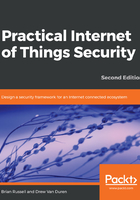
Real-time operating systems
IoT devices often employ a Real-Time Operating System (RTOS) for process and memory management, as well as utility services supporting messaging and other communications. The selection of each RTOS is based on needed performance, security, and functional requirements of the product. There are many RTOS available, including those noted here:

Many IoT device profiles are shrinking to small but powerful SoC units, capable of running a variety of secured-boot operating systems, featuring strict access controls, process isolation, trusted execution environments, kernel separation, information flow control, and tightly integrated cryptographic security architectures. Safety-critical IoT devices employ RTOS that meet industry-specific standards. Examples of these include the following:
- DO-178B: Software considerations in airborne systems and equipment certification for avionics systems
- IEC 61508: Functional safety for industrial control systems
- ISO 62304: Medical device software
- SIL3/SIL4: Safety integrity level for transportation and nuclear systems
Other critical security attributes pertain to security configuration and the storage of security sensitive parameters. Often configuration settings that are applied to an operating system are lost upon power cycle without battery-backed RAM or some other persistent storage. In many instances, a configuration file is kept within persistent memory to provide the various network and other settings necessary to allow the device to perform its functions and communicate. Of even greater interest are the handling of the root password, other account passwords, and the cryptographic keys stored on the devices when the device is power-cycled. Each of these issues has one or more security implications and requires the attention of security engineers.